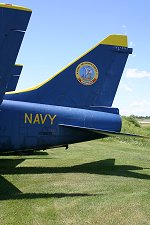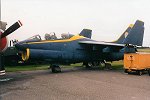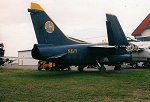|
AMERICAN WINGS AIR MUSEUM Navy BN 154500 |
|||||||
|
In 1962, United States Navy began preliminary work on VAX (Heavier-than-air, Attack, Experimental), a replacement for the A-4 Skyhawk with greater range and payload. A particular emphasis was placed on accurate delivery of weapons to reduce the cost per target. The requirements were finalized in 1963 and in 1964 the Navy announced the VAL (Heavier-than-air, Attack, Light) competition. Since the upcoming General Dynamics F-111B was supposed to fulfill the advanced strike role, the NAL was intended to be only an interim solution. To minimize costs, all proposals had to be based on existing designs. Vought, Douglas Aircraft, Grumman, and North American Aviation responded. The Vought proposal was selected as the winner on 11 February 1964, and on 19 March the company received a contract for the initial batch of aircraft, designated A-7. In 1965 the aircraft received the popular name Corsair II, after Vought's highly successful F4U Corsair of World War Two. The A-7 was based on the F-8 Crusader fighter but h ad a shorter, broader fuselage, and a larger wing. The Crusader's variable incidence wing was deleted. To achieve the required range, A-7 was powered by a Pratt & Whitney TF-30-Р-6 turbofan shared with the F-111 producing 11,345 lbf (50.5 kN) of thrust. Since supersonic performance was not required, the engine was not fitted with an afterburner. The aircraft was fitted with an AN/APQ-116 radar integrated into the ILAAS digital navigation and weapons computer. It was one of the first aircraft to have a modern heads-up display HUD which displayed information such as dive angle, airspeed, altitude, drift, and aiming reticle. The integrated navigation system allowed for another innovation -- the projected map display system (PMDS) accurately showed aircraft position on two different map scales.The A-7 enjoyed the fastest and most trouble-free development period of any American combat aircraft since the second world war. The YA-7A made its first flight on 27 September 1965, and began to enter Navy squadron service late in 1966. The first Navy A-7 squadrons reached operation status on 1 February 1967, and began combat operations over Vietnam in December of that year. Production of Corsairs continued through 1984. A total of 1,569 aircraft were built. |
|||||||
|
|
|
||||||
|
|
|
|
|||||
|
|
|
|
|||||
|
|
|
|
|
||||






